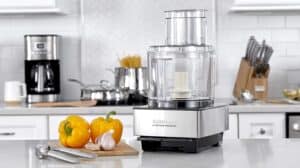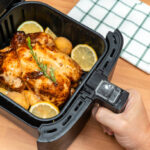Choosing a food processor is about finding the right one for you based on your culinary aspirations, household size, budget, storage preferences, etc. You also need to understand the different types of food processors and their features when making your purchase. To make the tasks more manageable, you can read this article covering the various important parameters when choosing the best food processor and helping you make the best decision possible.

Table of Contents
Best Capacity Size For Food Processor
The capacity of the food processor is one of the most important factors to consider when making your purchase. It determines how much food you can process at one time, and this capacity can be divided into three categories – large, medium, and small (food chopper).
- Large food processors with a capacity of 8 — 14 cups or more are ideal for larger families or those who entertain often. A few Large models may include one or two additional mini bowls, which fit in the main bowl and is helpful if you want to process a smaller amount of food, such as chopping herbs or nuts. In addition, they typically come with multiple blades, discs, and other accessories to help you tackle more complex tasks like shredding, slicing, dicing, or kneading dough.
- The next size down is a medium food processor with 4 to 7 cups. They have all the functions of a large food processor, just with a smaller work bowl and weaker motor. If your daily cooking is mainly for one or two people, a medium-size unit should be a fantastic choice.
- The gadgets with a capacity of fewer than 4 cups should be confided not as standard food processors but rather as food choppers. They have limited functionality but are best for quick chopping, mixing, pureeing, mincing, or basic food prep tasks.
What size of Food Processors you should get depends on the task and functions you are looking to accomplish.
It would also help to remember the difference between the liquid and dry food processor capacity. The dry capacity is usually smaller than the liquid, and the liquid capacity is what the seller will usually tell on the gadget box.
Motor Power
The typical food processor usually has motor power starting from 300 to 1300 watts. The bigger the capacity and attachments set, the stronger the motor because it has to run a bigger food batch and performs more tasks varieties. A good starting point is to look for a food processor with a motor of at least 500 watts. With ample power, the gadget is capable of more challenging tasks.
Most units are also equipped with safety measures and motor protection systems. So, the unit will not start unless it has been assembled correctly, and cut off power if it is overheated.
Attachments and Functionality
Typically, a food processor comes with a set of accessories, including a chopping blade, Slicing Disc, Shredding Disc, and Dough Hook.
- S‑blade or chopping blade is the standard blade that will perform most of your food processing tasks, such as chopping, mincing, and combining ingredients for a dip, sauces, salad dressings, pesto, and hummus, or salsa.
- Slicing Disc resembles a regular cut knife designed for slicing veggies, fruits, cheese, and sometimes meat. The opening on the slicer determines the thickness of the slices. Some models may come with a reversible slicing disc, with one side for thick slicing and the other for thin slicing. The other type of slicing disc is a variable one adjusted with a tuning dial, giving you even more control over the thickness of your ingredients.
- Grating or Shredding Disc mimics manual grating and is suitable for shredding large batches of food, such as coleslaw and other recipes. It is usually reversible that handles thick and thin grating tasks. At the same time, some brands offer two separate discs for both sizes.
- Dough Tool is designed similar to the S blade, except it is made from hard plastic. It is kneading dough for bread, pizza, cookies, pasta, etc. It is ideal for a baker who does not have space or budget for a separate stand mixer.
A quality food processor may include additional attachments that come in the set or are available to buy separately. These include a spiralizer or julienne disc that makes the decorative slicing for an artistic finish, a French fry disc for healthy homemade chips, dicing blades, and accessories storage cases. In addition, some food processors can offer extended attachment options that include blenders and mini-mills for spices for even more versatility at mealtime.
Feed Chute Size
When it comes to buying a food processor, the size of the feed chute is one of the crucial parameters. The large feed tube can process larger items, such as potatoes or cucumbers, without chopping them up first. It also allows food to be easily pressed into the cutting discs and can be adjusted for different food shapes. So, the bigger Feed Chute, the better.
Control Panel
Food processors usually are equipped with a simple control panel. Some come with only one Continuous or Pulse Speed. More advanced models can have few speeds and even pre-set programs.
However, this gadget needs no more than Low and High speeds and a Pulse function; anything more than that is an excessive option. Slow speed allows the processing of soft ingredients, while hard speed handles hard ingredients. In addition, the pulse usually performs chopping functions and allows controlling the size of chopped pieces. Since if you use continuous speed for chopping, you are likely to over-process this.
How Easy To Set Up And Clean
Washing food processor attachments by hand can be a real pain. If you have a dishwasher, look for a model with dishwasher-safe accessories. Most Food Processors come with an attachment that is safe to clean on the top rack of the dishwasher.
Size and Weight
The size and weight of Food Processors are other essential features because most of them are pretty hefty and tall. If you want to keep the gadget on your countertop, make sure it fits under your kitchen cabinet, so it should have a profile of fewer than 18 inches. The device lid with the feed tube must also fit under the cabinet; otherwise, you have to have a space to keep them separately since the feed tube could be tall and bulky.
If you minimalist-style kitchen and do not keep appliances outside, you have to make sure you have a cupboard space to store them and lift them easily. Some units are hefty and can weigh more than 20 lbs.
Food Processor Cost
They are not the cheapest appliances around. For example, the proper food processor could cost about $600, such as Breville or Magimix machine. Others could be around $100 while equipped with all major accessories, such as a Ninja Food Processor.
However, keep in mind that the most popular food processor will cost between $200 and $400. So, ultimately, the best way to decide how much to spend is by setting your budget and finding the best model for that price.
Summary
This guide is designed to help you find the best food processor for your needs. By understanding the different features and options available, you can make an informed decision and find a suitable food processor for your kitchen.
If you find this article helpful, please drop a comment to let us know. We would appreciate it.




